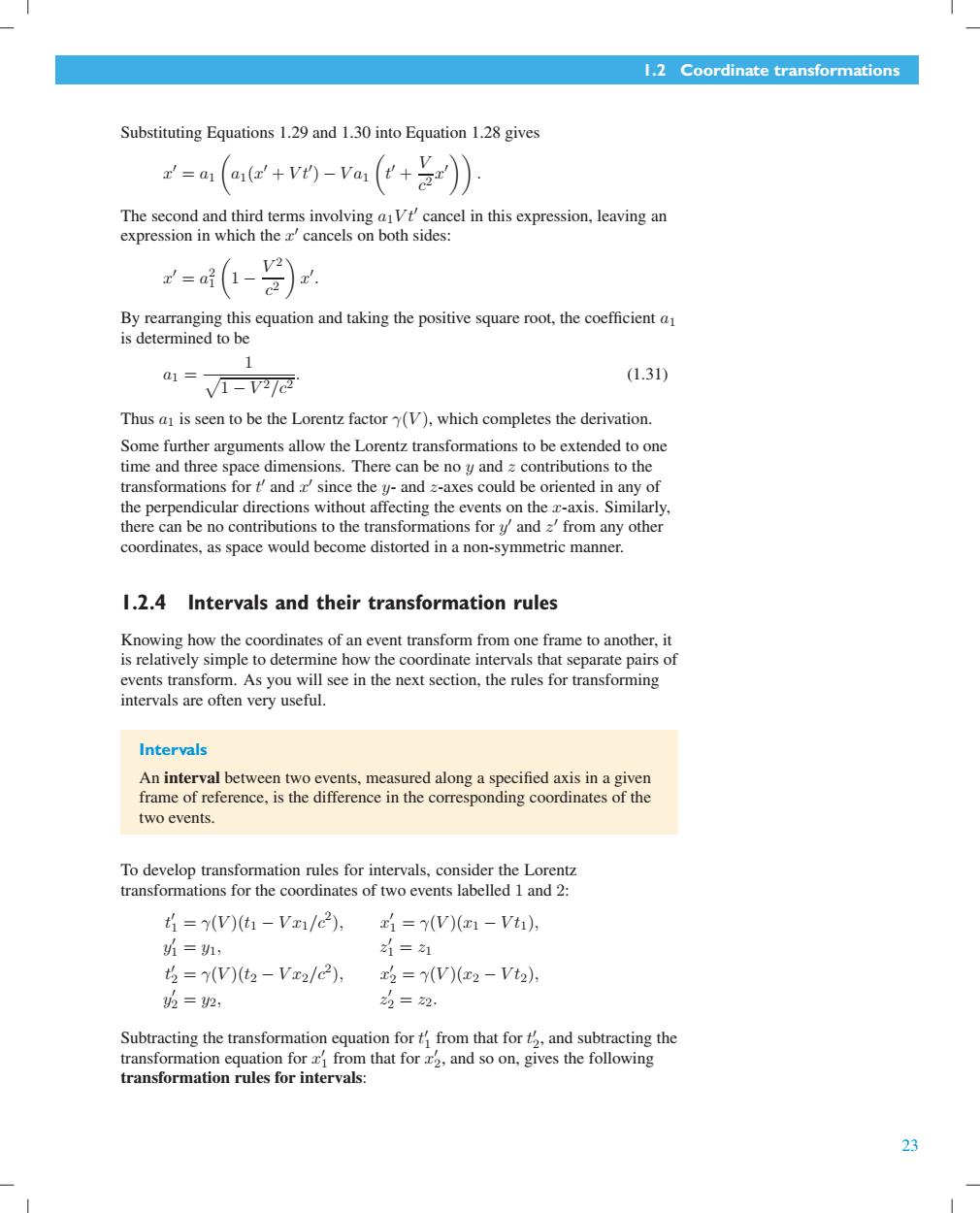正在加载图片...

1.2 Coordinate transformations Substituting Equations 1.29 and 1.30 into Equation 1.28 gives x'=a1 a+v-va(+)) The second and third terms involving aVt'cancel in this expression,leaving an expression in which the z'cancels on both sides: By rearranging this equation and taking the positive square root,the coefficient a is determined to be 1 a1= (1.31) V1-V282 Thus a1 is seen to be the Lorentz factor (V),which completes the derivation. Some further arguments allow the Lorentz transformations to be extended to one time and three space dimensions.There can be no y and z contributions to the transformations for t'and since the y-and z-axes could be oriented in any of the perpendicular directions without affecting the events on the x-axis.Similarly, there can be no contributions to the transformations for y'and a'from any other coordinates,as space would become distorted in a non-symmetric manner. 1.2.4 Intervals and their transformation rules Knowing how the coordinates of an event transform from one frame to another,it is relatively simple to determine how the coordinate intervals that separate pairs of events transform.As you will see in the next section,the rules for transforming intervals are often very useful. Intervals An interval between two events,measured along a specified axis in a given frame of reference,is the difference in the corresponding coordinates of the two events. To develop transformation rules for intervals,consider the Lorentz transformations for the coordinates of two events labelled 1 and 2: =(V)(ti-Vz/c2), =(v)(z1-Vt), 1=1, 才= t6=y(V(t2-Vx2/c2), x2=y(V)(x2-Vt2), 2=2, 为=2 Subtracting the transformation equation fort from that for t,and subtracting the transformation equation for from that for and so on,gives the following transformation rules for intervals: 231.2 Coordinate transformations Substituting Equations 1.29 and 1.30 into Equation 1.28 gives x % = a1 ? a1(x % + V t% ) − V a1 ? t % + V c 2 x % @@ . The second and third terms involving a1V t% cancel in this expression, leaving an expression in which the x % cancels on both sides: x % = a 2 1 ? 1 − V 2 c 2 @ x % . By rearranging this equation and taking the positive square root, the coefficient a1 is determined to be a1 = 1 - 1 − V 2/c2 . (1.31) Thus a1 is seen to be the Lorentz factor γ(V ), which completes the derivation. Some further arguments allow the Lorentz transformations to be extended to one time and three space dimensions. There can be no y and z contributions to the transformations for t % and x % since the y- and z-axes could be oriented in any of the perpendicular directions without affecting the events on the x-axis. Similarly, there can be no contributions to the transformations for y % and z % from any other coordinates, as space would become distorted in a non-symmetric manner. 1.2.4 Intervals and their transformation rules Knowing how the coordinates of an event transform from one frame to another, it is relatively simple to determine how the coordinate intervals that separate pairs of events transform. As you will see in the next section, the rules for transforming intervals are often very useful. Intervals An interval between two events, measured along a specified axis in a given frame of reference, is the difference in the corresponding coordinates of the two events. To develop transformation rules for intervals, consider the Lorentz transformations for the coordinates of two events labelled 1 and 2: t % 1 = γ(V )(t1 − V x1/c2 ), x% 1 = γ(V )(x1 − V t1), y % 1 = y1, z% 1 = z1 t % 2 = γ(V )(t2 − V x2/c2 ), x% 2 = γ(V )(x2 − V t2), y % 2 = y2, z% 2 = z2. Subtracting the transformation equation for t % 1 from that for t % 2 , and subtracting the transformation equation for x % 1 from that for x % 2 , and so on, gives the following transformation rules for intervals: 23